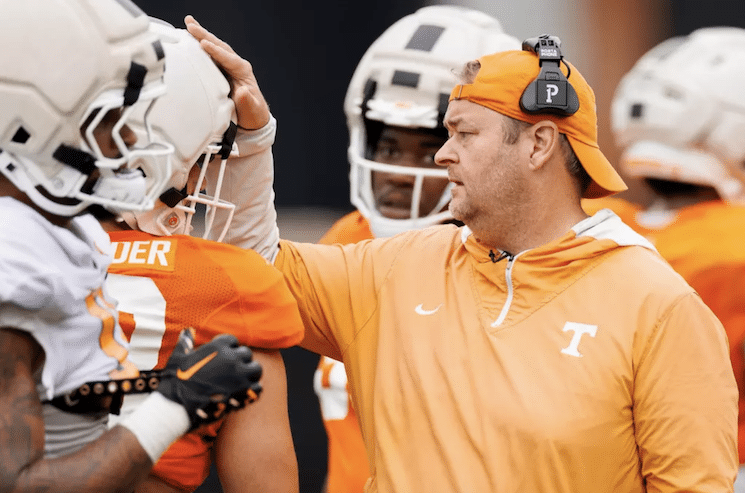
For the first time since 2008, Tennessee fell in a season opener. The Vols were blitzed by No. 17 West Virginia 40-14 in Charlotte to begin the Jeremy Pruitt era, and it marked the first time since 1977 that a UT head coach lost his debut game on the sidelines.
There were several reasons why the Vols lost the way they did on Saturday. Tennessee was presented with a lot of bad match-ups on the field, and it showed. A young secondary had to contain one of the best receiving corps in college football, and the Vols’ pass rush had to go against one of the better offensive lines they’ll face all season as well.
All that added up to a recipe for success for Heishman hopeful quarterback Will Grier as he tossed a career-high 429 yards and five touchdowns while completing 73.5 percent of his 34 pass attempts.
Now, we go back and evaluate some of the reasons why Tennessee earned the outcome they did. Here are the key numbers from the Vols’ 40-14 loss to West Virginia.
Third Down Rate and Distance
Tennessee started out strong on third down both on offense and defense. They didn’t force a number of third downs on defense in the first half, but when they did, they kept West Virginia from converting. The Mountaineers faced three third downs in the first half and failed to pick up any of them. Tennessee, meanwhile, was 5-of-10 on third down conversions in the first half.
The script completely flipped in the second half, though.
West Virginia converted their first five third down attempts in the second half and only failed to convert on their very last attempt in the fourth quarter. They were 5-of-6 on third downs in the second half, and they scored a touchdown on one of those third down conversions. The Vols, meanwhile, were 0-for-4 on third downs in the second half.
As a whole, West Virginia’s average third down distance they faced was 5.7 yards. They only faced a distance of six yards or greater on third down five times. Tennessee’s average third down distance was 8.5 yards. The Vols twice committed penalties on third down that backed them up even more, and they faced eight third downs of six yards or more including five that were 10 yards or longer.
All in all, West Virginia converted 55.6 percent of their third downs while the Vols only converted 35.7 percent of theirs.
First Down Plays
Not only did Tennessee get burned on third downs, but West Virginia dominated on first down as well.
The Mountaineers ran 31 plays on first down and racked up a whopping 250 yards on those plays. They averaged 8.1 yards per play on first down and made nine first downs on the first play of downs. West Virginia also scored three of their five touchdowns on first down plays.
Tennessee, on the other hand, wasn’t nearly as effective on first down.
The Vols ran 26 plays on first down and picked up 168 yards. That’s an average of 6.5 yards per play on first down. Tennessee wasn’t ineffective on first down, but they just weren’t nearly as efficient as the Mountaineers were on first downs.
West Virginia picked up 26 first downs compared to 19 by Tennessee.
Yards Per Play
West Virginia was able to pick up big chunks of yards on multiple plays against Tennessee. And that was one of the Vols’ biggest downfalls in this game.
The Mountaineers averaged 8.97 yards per play in this contest. They had 13 plays go for 10 or more yards and eight plays on offense that gained 25 or more yards. West Virginia ended up totaling 547 yards of offense and averaged 17.2 yards per completion and 4.4 yards per rush.
The Vols averaged just 4.77 yards per play, which was their average for all of last season. That’s not a great sign to start the season for the Vols, but it’s not too bad considering how badly Tennessee started out in this game. The Vols’ first possession of the game actually lost them 15 yards, and their third possession lost them seven yards. Tennessee only had 27 yards of offense in the first quarter and averaged just 3.6 yards per play in the first half. They upped that to 6.4 yards a play in the second half.
Quarterback Pressure
One of the reasons Tennessee gave up so many big plays through the air was because they rarely pressured Will Grier. The Vols’ young secondary was already out-matched, and a lackluster pass rush didn’t help them one bit.
The Vols were credited with two sacks on the afternoon, but West Virginia only lost four yards on those sacks. Kyle Phillips was credited with two quarterback hurries while Darrell Taylor picked up one as well. But that was about it as far as quarterback harassment went for Tennessee.
Far too often, Grier had plenty of time to carve up Tennessee’s secondary, and even on the rare occasions that the Vols did get pressure on him, Grier would often escape and find a way to make a play. Grier finished the game completing seven consecutive passes and only had three incompletions in the entire second half.
Time of Possession
Tennessee came into this game wanting to control the time of possession, and they actually did just that. But they didn’t control it quite enough, and West Virginia was able to score a lot and score quickly.
The Vols had the ball for 32 minutes and 23 seconds while the Mountaineers possessed it for 27 minutes and 37 seconds. Tennessee may have won that battle, but they didn’t win too many others.
West Virginia had scoring drives of 1:52, 2:06, 2:18, 2:25, and 2:49 in this game. Their longest scoring drives were still less than five minutes, and both of those “longer” drives didn’t happen till late in the third quarter and in the fourth quarter.



